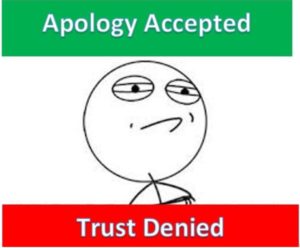
Once again, the start of another New Year has me thinking about faith, trust, and personal space. Or more succinctly – boundary issues. Specifically, trust.
Trust has traditionally been a sticky wicket for me. Some people spend large amounts of time making people “earn” their trust and loyalty. I’m quite the opposite. Assuming my intuition doesn’t tell me to head for the hills, I will endeavor to trust first and figure things out as I go. Silly me, I don’t even give up after a big blow up. I always give at least second chances because by my reckoning – everybody has a bad day now and then and, nobody’s perfect.
Building resilience can simply mean not retreating when things get tough. It’s easy to cut and run, unfriend or block people when we’re upset or offended. But it takes a very deep emotional skill-set to puzzle things through to some kind of reasonable conclusion. Notice that I said “reasonable” not happy.
Recently, one of my favorite television characters said something that became a lightbulb moment for me: “Why does everything have to be understandable? Why can’t some things be unacceptable and we just say that?” Thus, the subject of boundaries.
The long and short of it is this – Boundaries? Get some. Why? Because some behaviors and actions are simply not acceptable. Often, we feel it as it’s happening, but we definitely know for sure when all is said and done.
Creating and maintaining healthy boundaries is vital to building self-esteem and is absolutely mandatory in all relationships. Healthy boundaries give us a safety zone, a place of respite or emotional comfort, if you will. Setting boundaries is a skill learned on the fly. As one of my fellow MHI bloggers pointed out: “I wasn’t taught how to set healthy boundaries.” Truer words were never spoken, because no one is ever given lessons on how to begin or continue our relationships. From friendships to relatives to our intimate partnerships – we tend to learn as we go. In our formative years, we gather information by mimicking what we see in our homes and at school.
As adults, we usually seek out a comfortable way of navigating through our lives that’s tolerable enough to hold us, until something happens that forces us to scrutinize our choices. Usually we aren’t prompted to evaluate our life decisions until something goes catastrophically wrong. No judgement there, we’re all human. Character however, is forged in dire circumstances, not in the comfort of day to day living. How, for instance do we react when our trust is broken? Do you lash out, giving as good as you get to “even the score”? Perhaps you go no contact or grey rock? Or do you decide to accept an apology and forgive?
There are lots of tropes, memes and phrases about forgiveness, but what does it mean, and is it necessary to your overall self-care? Yes, and no. Let’s start with “what is forgiveness, anyway?” If you feel that you have been done a disservice, showing the transgressor mercy, compassion or understanding with the intent to go forward in peace is usually how most would define forgiveness. The entire process begins with an apology. Not the modern day “Oops, my bad” but an honest, sincere old school apology. According to a study conducted by Roy Lewicki of Ohio State University, there are six components to an effective apology. The most effective apologies contain as many of the six elements below as possible:
- Expression of regret – The offender states how badly they feel about what they have done. “I didn’t mean to hurt you…”
2. Explanation of what went wrong – Having the how and why of the misstep explained. “When “X” happened, I behaved/did…”
3. Acknowledgment of responsibility – Offender takes full responsibility for what transpired without blame shifting. “I made a bad decision/choice…”
4. Declaration of repentance – Statement of wrongdoing with statement to not repeat misdeeds. “It was wrong to do “X”, and I won’t do it again.”
5. Offer of repair – An offer to make things right. “I can do better. Can we start over so that I can put things right?”
6. Request forgiveness – Sincere request for or statement of intent to make amends. “I’m so sorry that I’ve hurt you, will you please accept my apology?”
According to Lewicki, at least two components must be present for the injured party to feel satisfied with the sincerity of the offender. But, what if you find that the aggressor is not expressing true remorse, or better still, doesn’t apologize at all? What then? Counter intuitive as this next bit may sound – it doesn’t matter.
WHAT!? (You’re making that face, aren’t you?)
It. Doesn’t. Matter. We need to forgive ourselves for not knowing what we didn’t know, and allow the fullness of time to bear things out in the long term. An apology can only go so far if the offender continues to behave in the same way as before or, is bold enough to amp up their negativity. That is when the resilience of healthy boundaries comes into play. Forgiveness is a gift. A token of faith and goodwill conferred upon someone for misdeeds. Even if that someone is us. Boundaries is a promise we make to ourselves internally to step away from people and situations that are harmful to our emotional wellbeing.
For example, if someone is constantly verbally abusive, and you’ve had numerous discussions about how it makes you feel yet, the aggressor continues to interact or communicate in a hurtful way, a primary boundary might be stepping away from the relationship until a calmer more positive way of exchanging information or ideas can be had. Choosing your own wellness over someone else is not negative if dealing with someone leaves one feeling drained, broken or disheartened.
Setting boundaries means knowing your own mind. Becoming familiar with your limits. What is the most you are willing to accept? This is important, especially when initially setting boundaries because there will be push back from those used to having their way. The moment we begin to feel resentment or that we’ve been taken advantage of, a boundary has been breached. Being guilt tripped up into a task, for instance can cause resentment because we begin to feel as if our feelings or contributions do not matter, and someone has decided to use our own empathy against us.
Give yourself permission to place your needs or considerations first. If you’re not harming someone else in doing so, self-care starts by allowing our needs to be considered as important as anyone else’s. Be direct, and firm when stating our needs. Use “I” statements, and shy away from sarcasm, aggression and negativity when setting boundaries. Be assertive, but not combative.
Be prepared for at least a little push back. While some will applaud your efforts to take your life back, those that have become accustomed to disregarding your personal space emotionally, may react with disapproval or even outright hostility. Let them. They’re probably the reason you’re enforcing your new boundaries in the first place.
Always seek support. From an emotional battle buddy, a support group, or therapeutic team. Having someone to confide in can make the task of honoring your new agreement with yourself much easier.
Now that we have a somewhat clearer picture of what it means to create boundaries and why we need them, one of the most difficult parts of the entire transaction can be implementing our new emotional standards. It takes about twenty-one days to form a new habit. Hopefully, no one needs this form of conflict resolution every day for nearly a month, but don’t give up. As with anything new, the first few tries will feel unfamiliar; especially when you’re accustomed to sacrificing your comfort to avoid conflict or discomfort. Give it time. The payoff comes when we stand in our truth and weather the slings and arrows of life with confidence and grace.
Please remember, we do not have to accept assaults on our emotional or even physical boundaries. The only behavior we can control is our own. If you have a wellness plan, work it. It works when we do. Pop- culture says that we teach people how to treat us. If that’s true, let’s decide not to accept substandard behavior.
If someone continues to push the envelope even after numerous failed or abandoned attempts to make amends, we are not required to accept poor behavior. The next time someone offers platitudes or an insincere apology as a means of staying in our sphere, we have the right to act accordingly: Apology graciously accepted; trust and loyalty categorically denied.
Read more at: http://transcripts.foreverdreaming.org/viewtopic.php?f=51&t=30473
The 6 elements of an effective apology, per science |The Ohio State University
https://news.osu.edu/news/2016/04/12/effective-apology/

Dominique is a Mental Health Advocate, who has served on the board of directors of a NAMI affiliate. She continues her work as a support group facilitator, and resource advisor for a local Family to Family class. She is a trauma and abuse survivor who struggles with and survives the ebb and flow of having PTS. (She is adamant about dropping the “D” – feeling that it is unnecessarily stigmatizing).
Her journey to advocacy began at a tipping point in her marriage when she asked her husband about his diagnosis – Bipolar Depression. When he could not answer her very pointed questions, she was led to NAMI, where she found fellowship in a support group, and a family education course that changed the way she viewed her role as a caregiver, her diagnosis and that of her husband and mother-in-law.
Dominique revels in the art of cooking and paper crafting. She makes handmade cards for special occasions. Dominique states, “I feel grace and oddly peaceful when I make cards or cook. And I won’t do either for people I don’t like because it is a gift from my heat.” She is also an avid photographer. In her spare time, Dominique is very active on social media, having created and posting on Facebook and Twitter accounts for her local NAMI affiliate. She also co-moderates a Facebook support group about Mental Wellness, and is a writer of short stories based on her favorite television shows and movies.